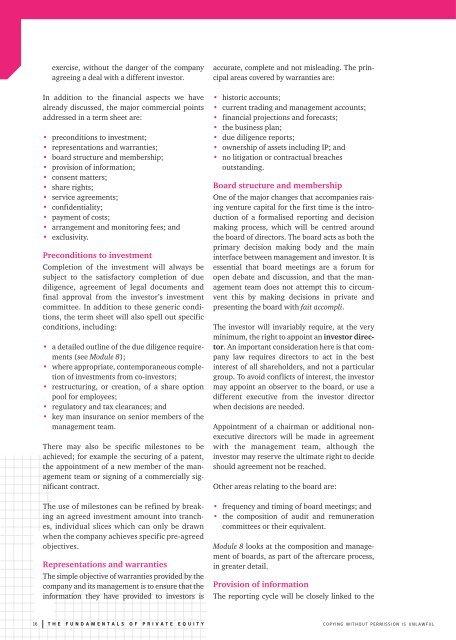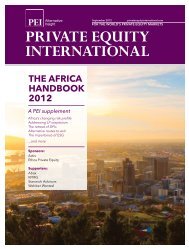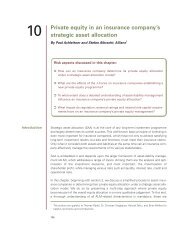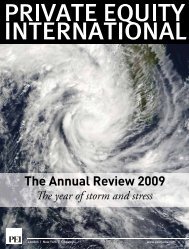Fundamentals of Private Equity and Venture Capital - PEI Media
Fundamentals of Private Equity and Venture Capital - PEI Media
Fundamentals of Private Equity and Venture Capital - PEI Media
Create successful ePaper yourself
Turn your PDF publications into a flip-book with our unique Google optimized e-Paper software.
exercise, without the danger <strong>of</strong> the company<br />
agreeing a deal with a different investor.<br />
In addition to the financial aspects we have<br />
already discussed, the major commercial points<br />
addressed in a term sheet are:<br />
• preconditions to investment;<br />
• representations <strong>and</strong> warranties;<br />
• board structure <strong>and</strong> membership;<br />
• provision <strong>of</strong> information;<br />
• consent matters;<br />
• share rights;<br />
• service agreements;<br />
• confidentiality;<br />
• payment <strong>of</strong> costs;<br />
• arrangement <strong>and</strong> monitoring fees; <strong>and</strong><br />
• exclusivity.<br />
Preconditions to investment<br />
Completion <strong>of</strong> the investment will always be<br />
subject to the satisfactory completion <strong>of</strong> due<br />
diligence, agreement <strong>of</strong> legal documents <strong>and</strong><br />
final approval from the investor’s investment<br />
committee. In addition to these generic conditions,<br />
the term sheet will also spell out specific<br />
conditions, including:<br />
• a detailed outline <strong>of</strong> the due diligence requirements<br />
(see Module 8);<br />
• where appropriate, contemporaneous completion<br />
<strong>of</strong> investments from co-investors;<br />
• restructuring, or creation, <strong>of</strong> a share option<br />
pool for employees;<br />
• regulatory <strong>and</strong> tax clearances; <strong>and</strong><br />
• key man insurance on senior members <strong>of</strong> the<br />
management team.<br />
There may also be specific milestones to be<br />
achieved; for example the securing <strong>of</strong> a patent,<br />
the appointment <strong>of</strong> a new member <strong>of</strong> the management<br />
team or signing <strong>of</strong> a commercially significant<br />
contract.<br />
The use <strong>of</strong> milestones can be refined by breaking<br />
an agreed investment amount into tranches,<br />
individual slices which can only be drawn<br />
when the company achieves specific pre-agreed<br />
objectives.<br />
Representations <strong>and</strong> warranties<br />
The simple objective <strong>of</strong> warranties provided by the<br />
company <strong>and</strong> its management is to ensure that the<br />
information they have provided to investors is<br />
accurate, complete <strong>and</strong> not misleading. The principal<br />
areas covered by warranties are:<br />
• historic accounts;<br />
• current trading <strong>and</strong> management accounts;<br />
• financial projections <strong>and</strong> forecasts;<br />
• the business plan;<br />
• due diligence reports;<br />
• ownership <strong>of</strong> assets including IP; <strong>and</strong><br />
• no litigation or contractual breaches<br />
outst<strong>and</strong>ing.<br />
Board structure <strong>and</strong> membership<br />
One <strong>of</strong> the major changes that accompanies raising<br />
venture capital for the first time is the introduction<br />
<strong>of</strong> a formalised reporting <strong>and</strong> decision<br />
making process, which will be centred around<br />
the board <strong>of</strong> directors. The board acts as both the<br />
primary decision making body <strong>and</strong> the main<br />
interface between management <strong>and</strong> investor. It is<br />
essential that board meetings are a forum for<br />
open debate <strong>and</strong> discussion, <strong>and</strong> that the management<br />
team does not attempt this to circumvent<br />
this by making decisions in private <strong>and</strong><br />
presenting the board with fait accompli.<br />
The investor will invariably require, at the very<br />
minimum, the right to appoint an investor director.<br />
An important consideration here is that company<br />
law requires directors to act in the best<br />
interest <strong>of</strong> all shareholders, <strong>and</strong> not a particular<br />
group. To avoid conflicts <strong>of</strong> interest, the investor<br />
may appoint an observer to the board, or use a<br />
different executive from the investor director<br />
when decisions are needed.<br />
Appointment <strong>of</strong> a chairman or additional nonexecutive<br />
directors will be made in agreement<br />
with the management team, although the<br />
investor may reserve the ultimate right to decide<br />
should agreement not be reached.<br />
Other areas relating to the board are:<br />
• frequency <strong>and</strong> timing <strong>of</strong> board meetings; <strong>and</strong><br />
• the composition <strong>of</strong> audit <strong>and</strong> remuneration<br />
committees or their equivalent.<br />
Module 8 looks at the composition <strong>and</strong> management<br />
<strong>of</strong> boards, as part <strong>of</strong> the aftercare process,<br />
in greater detail.<br />
Provision <strong>of</strong> information<br />
The reporting cycle will be closely linked to the<br />
16 THE FUNDAMENTALS OF PRIVATE EQUITY<br />
COPYING WITHOUT PERMISSION IS UNLAWFUL

















